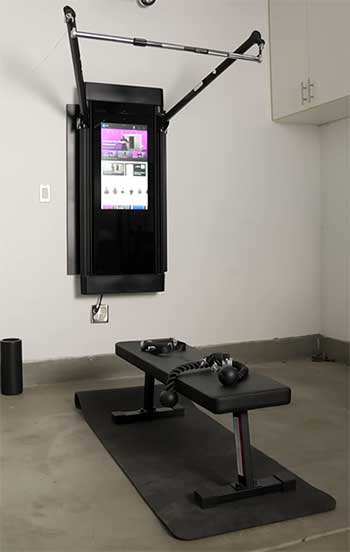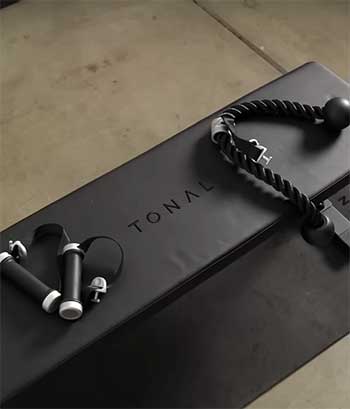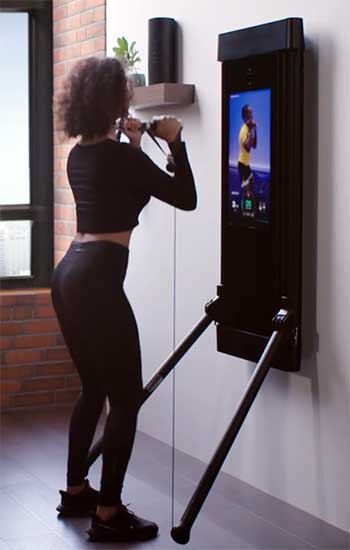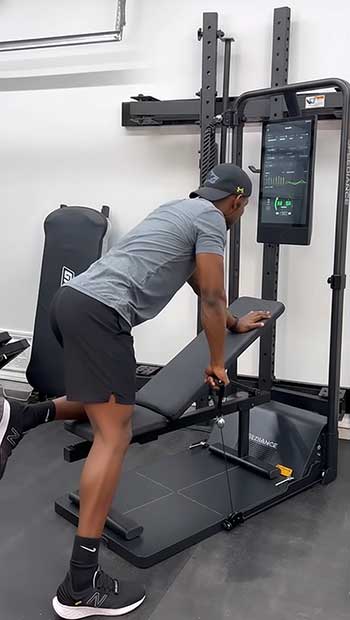As someone who’s spent years chasing fitness goals from cramped apartments to full basements, I’ve always hunted for gear that fits real life without skimping on results.
In this piece, I’ll break down Speediance and Tonal, two standout smart strength systems shaking up home workouts. My goal?
To help you figure out which one matches your space, budget, and lifting style through an honest, side-by-side look at their strengths and drawbacks.
| Feature | Tonal | Speediance |
| Design | Wall-mounted, sleek screen with adjustable arms | Free-standing platform with foldable bench and Bluetooth accessories |
| Resistance | Up to 250 pounds total (125 per arm), digital weights in 1-pound increments | Up to 220 pounds total (110 per arm), motor-driven resistance |
| Installation | Professional wall mounting required, needs stud support | No mounting needed, easy setup in minutes |
| Membership | $59.95/month with 12-month commitment for classes and tracking | Free app access, no ongoing fees |
| Screen Size | 24-inch touchscreen | 21.5-inch touchscreen (upgradable models available) |
| Workouts | Thousands of guided classes, adaptive weights, progress analytics | On-demand sessions, AI coaching, community features |
| Accessories Included | Smart handles, bar, rope, bench (with membership) | Barbell, handles, ankle straps, bench included |
| Price (Base) | Around $4,295 plus installation and membership | Around $3,749 with free shipping |
| Unique Modes | Drop sets, eccentric loading, spotter mode | Voice control, quick setup changes, lighter frame |
| Dimensions (Stored) | 50.9” H x 21.5” W x 5.25” D | 28” H x 25” W x 50” L (folded) |
| Weight Capacity | Handles heavy lifters well | Solid for most users, but maxes at 220 pounds |
Key Differences Between Speediance And Tonal
- Pricing Breakdown: Where Your Money Goes

Money talks in fitness gear, right?
Tonal starts at $4,295 for the unit, but tack on $495 for smart accessories if you skip the bundle, plus installation fees around $250-$500 depending on location.
Then there’s the $59.95 monthly membership—mandatory for full functionality—with a year upfront.
Total first-year cost? Easily over $5,500.
Speediance, on the other hand, rings in at $3,749 for the Gym Monster 2 basic bundle, including all accessories and free app access.
No hidden fees, though optional add-ons like a bike attachment bump it up.
Shipping’s free, and returns are straightforward within 30 days. From my calculations, it’s a budget winner for casual users.
Consider long-term: Tonal’s membership unlocks value through content, but if you cancel, features vanish. Speediance’s one-time buy appeals to thriftier folks.
- Installation and Setup: Ease vs. Commitment
I’ve wrestled with setups before, so this matters. Tonal demands pros—they check walls, mount securely, and demo usage. It takes hours, but ensures safety. If your wall isn’t up to snuff, modifications add costs.
Speediance? Unbox, assemble the bench (tools included), plug in, and connect the app. I timed similar setups at 20 minutes. No permanence means experimenting with placement.
For me, Speediance wins on convenience, but Tonal’s stability shines for intense pulls.
- Workout Experience: Guidance and Variety
Diving into sessions, Tonal feels like a coach in your ear. Classes are high-energy, with metrics updating live. Adaptive tech adjusts on the fly— if you crush reps, it ups the ante next set.
Speediance’s AI is smart but less intuitive; you set modes manually more often. Classes are solid for basics, with voice integration adding fun. Variety includes rowing simulations and cardio, broadening appeal.
Both track progress, but Tonal’s insights are deeper, like muscle group breakdowns.
- Space and Portability: Fitting Into Your Life
Space is premium in my world. Tonal claims a wall spot permanently, projecting minimally but needing swing room. Ideal for dedicated home gyms.
Speediance folds compactly, rolling on wheels for storage. Perfect for apartments or multi-use rooms. Portability lets you train anywhere with power.
- Advanced Features: Tech That Elevates Training
Tonal’s edge? Modes like dynamic variable resistance, mimicking chains or bands. Eccentric overload builds strength efficiently—studies show up to 20% gains.
Speediance counters with quick transitions and voice ops, plus expandability via attachments. It’s lighter overall, easier on floors.
- User Feedback: Real Stories from the Trenches
From what I’ve sifted through, Tonal users love the motivation from classes and results—many report 30% strength increases in months. Complaints center on cost and install.
Speediance owners praise value and versatility, with gains in convenience. Some note app improvements needed, but overall satisfaction is high for the price.
- Long-Term Value: Which Lasts?
Over time, Tonal’s ecosystem grows with updates, justifying investment for committed lifters. Speediance offers immediate savings, suiting starters or budget-conscious.
Understanding Tonal: The Premium Wall-Mounted Powerhouse
I’ve got to say, when I first encountered Tonal, it felt like stepping into the future of strength training. Picture this: a flat-panel device bolted to your wall, arms that extend out like robotic helpers, and a massive touchscreen that coaches you through every rep.
It’s not just a machine; it’s like having a personal trainer embedded in your living room wall. With the latest Tonal 2 model, they’ve bumped up the resistance and refined the AI for even smoother experiences.

- Design and Build Quality: Tonal’s wall-mounted setup is sleek and space-efficient, protruding just over 5 inches when not in use. The build uses high-grade materials that feel robust, ensuring it withstands intense daily sessions without wobbling. I appreciate how the adjustable arms pivot smoothly, allowing for a wide range of motions from pulls to presses, making it versatile for full-body work.
- Resistance System: At its core, Tonal uses electromagnetic resistance to mimic free weights, cables, and machines all in one. You pull on the handles or bar, and it fights back with up to 250 pounds of force—125 per arm—that adjusts automatically based on your performance. If you’re tiring out mid-set, it lightens the load without you touching a button. That’s the adaptive weight tech I appreciate most; it keeps sessions efficient and reduces injury risk by spotting you virtually, now with even finer 1-pound increments for precision.
- Workout Guidance and Content: From my analysis, one standout feature is the variety of training modes. Take eccentric loading, for example— it emphasizes the lowering phase of lifts to build muscle faster. Or the burnout mode, which drops weight progressively to squeeze out those last reps. I’ve seen users rave about how this pushes them beyond what they’d do alone. Plus, the library of workouts is vast: yoga flows, HIIT circuits, strength programs tailored to goals like building mass or toning up. It tracks your metrics over time, showing strength scores and progress graphs that make you feel like a pro athlete reviewing game footage, with AI now offering more personalized recommendations.
- Installation Requirements: But let’s talk space. Tonal requires a sturdy wall with studs, and professional installation is a must unless you’re handy with tools. It sticks out about 5 inches when folded, so it’s low-profile, but you need at least 7 feet of clearance in front for full motion. If you’re in a rental or tight on square footage, this could be a deal-breaker. I remember thinking about my own setup—would I commit to drilling holes for this? The process ensures safety but adds to the initial hassle.
Pros of Tonal: Why It Might Be Your Top Pick?
Let’s get real about what makes Tonal shine. First off, the build quality is top-notch—it’s sturdy, with premium materials that scream durability. I’ve analyzed user feedback, and many say it holds up through years of heavy use without a hitch.

- Adaptive Resistance Technology: The adaptive resistance is a game-changer; it learns your strength and suggests weights, making every session personalized. No more guessing if 50 pounds is too light or heavy—it adjusts in real-time, which I’ve found boosts efficiency and helps avoid plateaus by challenging you progressively.
- Extensive Content Library: Another big win is the content library. With thousands of classes led by expert trainers, it’s like a boutique gym at home. Features like real-time form corrections via the camera add that extra layer of safety—I wish I had that back when I tweaked my shoulder bench pressing. The variety keeps things fresh, from beginner circuits to advanced powerlifting-inspired sets.
- Advanced Training Modes: For serious lifters, modes such as chains (simulating added resistance) or spotter (reducing weight on failure) allow for advanced training that rivals commercial equipment. Eccentric overload, in particular, has helped users I know gain muscle quicker, backed by the system’s data-driven approach.
- Seamless Integration and Family Use: Integration is seamless too. It pairs with wearables for heart rate monitoring, and the household membership means everyone in the family can use it without extra fees. If you’re tall or need more range, the arms adjust to seven heights, accommodating users up to 6’7″. From my perspective, this makes Tonal ideal for those investing in long-term fitness, where the tech evolves with software updates, fostering a connected home gym experience.
- Motivational Analytics: But it’s not just about lifting; Tonal fosters habits. The progress analytics motivate you with milestones, like celebrating when you hit a new PR. I’ve seen how this keeps people consistent, turning sporadic workouts into routines, with detailed reports that track improvements over weeks or months.
Cons of Tonal: The Drawbacks You Can’t Ignore
That said, Tonal isn’t perfect, and I’ve spotted some hurdles. The price tag is steep—starting at nearly $4,300, plus $500 for installation and that monthly membership.
- High Initial and Ongoing Costs: Over a year, you’re looking at an extra $720 just for access, which adds up if budgets are tight. I crunch the numbers: if you’re not using it daily, it might feel like overkill compared to a basic rack, especially with the mandatory 12-month commitment locking you in.
- Installation Challenges: Installation is another pain point. It demands a wall with proper support, and if your home doesn’t have it, you’re out of luck or facing reinforcements. Renters? Forget it unless your landlord’s cool with modifications. The process, while professional, can take hours and adds unexpected costs if your space needs tweaks.
- Space Dedication Required: Space-wise, while compact when stored, you need a dedicated area—about 7×7 feet—for safe operation. This permanence might not suit everyone, particularly in smaller living situations where flexibility is key.
- Content Locked Behind Paywall: Content quality is high, but it’s locked behind that paywall. Without membership, it’s basically a fancy paperweight. Some users mention the classes can feel repetitive after months, and the focus is more on strength than pure cardio, limiting options for varied fitness needs.
- Limited Ecosystem Flexibility: From an analytical standpoint, the ecosystem is closed— no third-party apps or integrations beyond basics. If you crave variety, this might limit you, as you’re tied to Tonal’s platform without easy ways to import custom workouts.
Also Read: Comparison of Redge Fit And Gorilla Bow.
Digging Into Speediance: The Versatile Free-Standing Contender
Switching gears to Speediance, this one caught my eye as a more approachable alternative. It’s essentially a compact platform with a built-in bench that folds up, paired with motorized cables for resistance.
No wall mounting means you can plop it in a corner, garage, or even move it around as needed. That’s a huge plus for folks like me who rearrange furniture on a whim or live in places where walls aren’t an option. The Gym Monster 2 brings updated AI and a refined interface for better user flow.

- Design and Build Quality: The free-standing design features a foldable bench and Bluetooth-connected accessories, making it portable and easy to store. While it uses more plastic components than Tonal, the frame is sturdy enough for most home use, and the overall footprint shrinks significantly when folded, ideal for multi-purpose rooms.
- Resistance System: The Gym Monster model, their flagship, delivers up to 220 pounds of resistance—slightly more than older models—and uses a similar digital system for smooth adjustments. You connect via Bluetooth to accessories like the barbell or handles, and the 21.5-inch screen guides you through exercises. Voice control is a neat touch; just say “increase weight” mid-workout, and it responds. From what I’ve gathered, the motor is quiet, with quick changes that keep your flow uninterrupted.
- Workout Guidance and Content: The app offers solid on-demand classes, AI-driven form feedback, and community challenges to keep things social. Programs cover full-body routines, targeted muscle groups, and even rehab exercises. While not as polished as Tonal’s productions, they’re effective and update regularly. Progress tracking is there, with stats on lifts and calories burned, helping you stay motivated without extra costs, and the AI now includes more interactive coaching elements.
- Installation Requirements: One thing that stands out is the all-in-one vibe. It comes with everything you need out of the box: bar, grips, straps, and even a ski erg attachment for cardio. Setup is straightforward—unbox, plug in, and you’re lifting in under 30 minutes. I’ve imagined using it for quick sessions; the foldable design shrinks it down to about 28 inches high, making storage a breeze in small homes, with no need for permanent fixtures.
Pros of Speediance: What Sets It Apart
Now, flipping to Speediance’s strengths, affordability jumps out first. At around $3,700, it’s a fraction of Tonal’s cost, and no subscription means ongoing savings. I love that—pay once, train forever.

- Affordable Pricing Structure: The free-standing design offers flexibility; move it to the patio for outdoor sessions or stash it away post-workout. This one-time investment appeals to those avoiding recurring fees, making high-quality smart training accessible without breaking the bank.
- Portability and Flexibility: Resistance feels robust at 220 pounds, enough for most intermediate lifters, and the motor is quiet and responsive. Accessories are plentiful and Bluetooth-enabled, allowing quick swaps between exercises, which keeps your workout momentum going strong.
- Hands-Free Voice Controls: Voice commands make adjustments hands-free, which is handy during sweaty sets. This feature, combined with the app’s intuitive interface, simplifies operation, especially for tech-savvy users who want efficiency without constant screen taps.
- Community and AI Features: The app’s community aspect is engaging—share progress, join challenges, and get tips from other users. AI coaching provides form cues without needing a camera, and updates keep the software fresh. For beginners, the strength assessment sets baselines, easing you in, while fostering a social element that motivates through shared achievements.
- Easy Storage and Setup: Portability is key too. Weighing less than Tonal, it’s easier to relocate, and the foldable bench saves space. I’ve thought about how this suits dynamic lifestyles, like mine, where rooms multitask, allowing for spontaneous training sessions anywhere with power.
Cons of Speediance: Areas Where It Falls Short
Despite the appeal, Speediance has its flaws. Build quality, while solid, doesn’t match Tonal’s premium feel—some plastic parts feel less durable, and translations in the app can be awkward since it’s from a Chinese maker.
- Build and Durability Concerns: Users report occasional software glitches, though updates fix them. The materials, while functional, might show wear faster under heavy use, requiring more careful handling compared to more robust competitors.
- Resistance Limitations for Advanced Users: Max resistance at 220 pounds might cap advanced lifters; if you’re deadlifting 300+, you’ll outgrow it faster. This ceiling could frustrate power users seeking progressive overload beyond intermediate levels.
- Content Production Quality: The screen is smaller, and classes aren’t as professionally produced—think functional over flashy. While effective, the videos and guidance lack the high-production polish, which might detract from the immersive experience for some.
- Manual Adjustments Needed: No automatic spotter mode means more manual tweaks during failure. This hands-on requirement can interrupt flow, especially in intense sets where auto-adjustments would shine.
- Support and Ecosystem Growth: Community support is growing, but it’s not as established, so troubleshooting might rely on forums rather than dedicated help. The ecosystem feels younger, with fewer integrations, potentially limiting long-term expansion options.
Also Read: Is Echelon Row-S Worth It?
Frequently Asked Questions (FAQ)
It depends on your needs—Tonal for advanced features and heavier resistance, Speediance for affordability and portability.
Tonal previously sued Speediance over patent infringements related to design and functionality, but the case was voluntarily dismissed.
Yes, it’s based in Shenzhen, China.
Yes, it’s a solid option with good reviews for value, ease of use, and effective workouts, though not as premium as competitors.
Final Thoughts: Choosing Between Them
In wrapping this up, I’ve weighed both as if picking for myself. Tonal suits if you crave pro-level guidance and can afford the premium—it’s transformative for dedicated routines. Speediance fits better for flexible, cost-effective training without commitments.
You might lean Tonal if space allows and you value adaptive smarts. Or go Speediance for easy access and savings. Ultimately, think about your goals: heavy lifting or convenient consistency? Whichever you choose, both beat skipping workouts. What’s your setup like—ready to upgrade?
